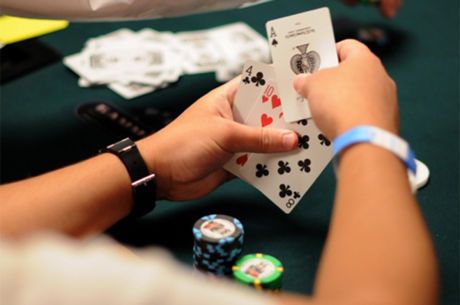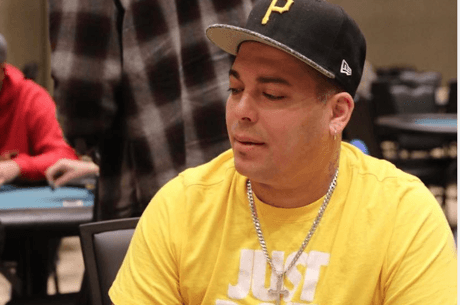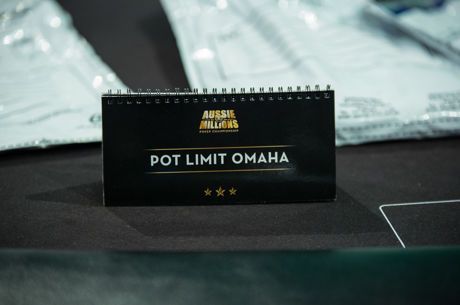Manage the Betting: A Few PLO Applications

In pot-limit Omaha, and in general, it��s a good idea to manage the betting throughout a hand in a way that is beneficial to your holding and costly for your opponents. The basic idea is, instead of putting all of your money in on whatever street is forcing you into a seemingly committed decision, you call and delay the decision until the next street.
So, instead of running out the equities at that juncture by going all-in, I suggest putting part of the money in early by calling, and then either put the rest of the money in with fewer cards to come (and hopefully greater equity for your hand) or fold on the next street if the tides have turned and you are no longer in a profitable position. I like to call this, ��managing the betting.��
In hold��em, most players are already familiar with how to apply this concept. One example is, say in a tournament, when a player calls a reraise with a small pair, then shoves any flop that doesn��t display an ace. The stop-n-go!
This concept also has many applications in pot-limit Omaha. Generally in PLO, hands have closer equities if put all-in when compared to hold'em. So, you often find yourself in a position where folding isn��t an option.
A situation where people already manage their betting
You and your opponent have $1,000. Let��s assume you��ve three-bet to $180 preflop with nine-eight-seven-six double-suited. Your opponent four-bets you to $600. You can't fold because your hand is +EV against any reasonable range your opponent could have here if you shoved. So what do you do, call or shove? Well, you know enough about your opponent to assume that he almost always has aces here (and if he doesn��t, he most likely has a strong kings hand, such as ace-king-king-ten, king-king-jack-jack, etc.). Against this range, you would be +EV to put all your chips in �D or $820 to win approximately $1,200 �D as you are a 45/55 dog against aces with two random side cards. But you can do better than that! If you call and see a flop like ace-two-three, ace-ace-five, two-three-queen, etc., you can safely fold. If you call and hit any part of the flop (pair, draws, etc.), then you simply put in your last $400. Everyone does this instinctively. You turn a +EV spot �D putting it all-in pre-flop �D into an even more +EV spot by calling, and then making an informed decision based on your opponent��s likely holding on the next street (in this case, the flop).
A situation where this may be less obvious
Let��s assume you have ten-eight-six-five, and there is $400 in the middle. The flop comes ten-eight-two with a flush draw. You bet $200, and get check-raised ��pot�� by your opponent to $1,000. Your opponent has another $1,500, and you��re certain that he��s going to move all-in. You cover, and the action is on you.
If you put it all-in right now, you are risking $2,300 more to win $3,100. With top-two pair, you are probably correct in doing this against many opponents. But in this spot it is probably even more profitable against many opponents to call the $800 more, and then put the last $1,500 in on any non-flush turn. Most opponents will not check-raise here with "drawy" hands that have straight draws with no flush draw [correctly] for fear of getting in stacks vs. hands with flush draws and being considerable dogs. So a very large part of your opponents range will be hands with flush draws, not to mention a set, which is already crushing you.
If a flush rolls off on the turn, your opponent will have you beat such a large percentage of the time that you can safely fold the $1,500, even though you can win at least $3,500. Yet if no flush card rolls off, you are getting in the last $1,500 on the turn with much better equity against all the drawy hands than you would have had you just committed on the flop. Thus, by managing the betting you can see that you break the hand up into a multistreet battle, instead of just an all-in situation on an earlier street. And that by managing the betting, you create a situation where your delayed decision adds equity to your hand and therefore must take it away from your opponents. The added equity from playing a hand this way can be strong enough to turn a situation (like this one) where going all-in on the flop vs. your opponent's range is slightly -EV (and thus you should fold), is now +EV after delaying your decision one street. Not sure? Think about it for a bit.
Remember, though, two very important assumptions were made in these situations
First, we assumed that we had a clear understanding of our opponent��s range of holdings. This is super-important because without this clear understanding (or if our understanding is inaccurate), you will end up making really bad decisions on the later street instead of good ones. In the flush example �D if your opponent check-raises with straight-draw hands that have no flush draw, than you will incorrectly fold whenever the flush card hits the turn, and incorrectly call every time a straight card hits. What a disaster!
Second, we assumed that our opponent will call the all-in bet if you raised on the earlier street. If we have fold equity for our earlier decision, then the math clearly changes. There is increased equity in our favor each time we shove and our opponent folds. But incorporating fold equity into our decision as to whether to raise or call is a concept for another time and another article, so for our purposes (and for many at the tables) our opponent is never folding, and we aren't either. So now you have to ask yourself, "Self, is it better to go all-in now, or to wait a street?"
There are many situations in any form of big-bet-poker where "Managing the Betting" is useful. It's practically dogma at this point to be aggressive, and when you think it is +EV to go all-in, to be the aggressor and be the "first one in." I suggest simply to "look before you leap," and as you consider hands, always think about whether or not you should delay the all-in to a later street by calling now and shoving later.
Sign up for a PokerNews Strategy account to learn more from the pros.








